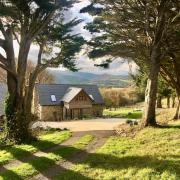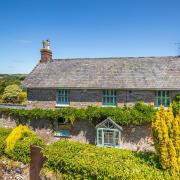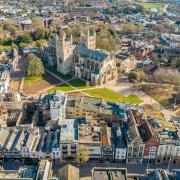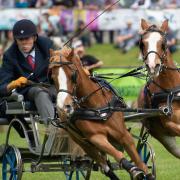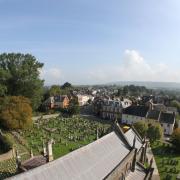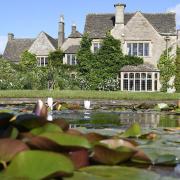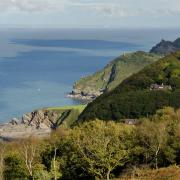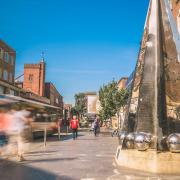The heavy horses that once came close to dying out have been put to a new use on Dartmoor. RACHAEL D’CRUZE-SHARPE experiences the majesty of these gentle giants first hand

Hailing from Scotland and originally used as agriculture and haulage workers, Clydesdales stand at over 18 hands and six feet long and grow to over 2,000 pounds. As well as being breathtakingly large, they are also undeniably beautiful with their distinctive feathers – the long hair above the hooves, thick manes and broad, straight handsome faces.
At the moment the breed may not be the first that springs to mind if you are to imagine going trekking, but, in Dartmoor at least, Tim Ancrum and Aileen Ware, of Adventure Clydesdale are changing that. Tim’s first experience of heavy horses came when he lived on the Isle of Sky, running a big estate. There was a lady there with big driving horses that began do passenger day rides, as well as riding them herself.
Tim, who wasn’t a rider until this point, reveals: “I fell in love with them. They were just so cuddly and they do everything I want.” It wasn’t long before he was he was a master horseman, riding from Sky to all the way to Cumbria in 2006. He says that it was during this marathon trek he realised just how good the Clydesdales are and where the idea for his adventure riding using them started. Moving to Cumbria, Tim set up Cumbria Heavy Horses, then relocated down to Bodmin, where his sister is based.
Visiting Dartmoor while living in Bodmin made Tim realise it was the place for him, his partner Aileen Ware, who he runs Adventure Clydesdale with, and of course for their Clydesdales too. Adventure Clydesdale is based at Brimpts Farm, which is close to Dartmeet. “It’s the best riding I’ve ever known anywhere – you have such freedom,” says Tim earnestly, while one of his big friendly giants affectionately nuzzles his shoulder.

Adventure Clydesdale specialises in long trail rides for up to five days, for experienced riders, as well as shorter rides including day rides and a half day trek, which is the shortest they do. “Lots of clients with stressful jobs come to ride with us – it’s a great way to wind down,” says Aileen. Tim agrees: “Being around horses is great for that, they’re great therapy.”
Tim are Aileen enthuse about how riding Clydesdales is an amazing way to see Dartmoor and about how well suited the horses are to the moor’s varied terrain. Rather than take their word for it, the couple invite me to experience it for myself and we agree that I’ll join them for a day’s ride. At this point I’ve never ridden a heavy, or even particularly large, horse before, but seeing how gently they interact with Tim and Aileen I’m excited rather than nervous.
I join four lovely northern ladies, Anna, Pauline, Gill and Clare, who do a five-day adventure ride with Adventure Clydesdale each year and used to ride with Tim at Cumbria Heavy Horses, for the first day of their trek. While Tim and Aileen get their horses ready for the off, I spend some time bonding with the horse I’ll be rising for the day – the majestic looking Faroe, who simply couldn’t have a nicer temperament or enjoy being made a fuss of more – I now understood what Tim had meant when he referred to the breed as ‘cuddly’ when we first met.
Brimpts Farm is in the heart of Dartmoor, so amazing riding ground is literally on the doorstep. I’m immediately impressed and, I admit, a little surprised by how comfortable it is to ride one of these big horses – they are responsive and sure footed and I felt confident on Faroe’s back at once. It was a good job too, as it was only a few minutes before we were on terrain I never thought I’d cross on horseback – over big uneven boulders, surrounded by trees, then straight through the East Dart River.

The six-hour ride showed me exactly what the Clydesdale breed are made of – they are incredibly well suited to the terrain of Dartmoor and, indeed, add to its beauty. Their intelligence and definite movements mean you’re able to negotiate tricky ground with ease. The horses have an eager gait, are graceful, eager to please and clearly enjoy the work. I was shocked by how quickly I felt I bonded with Faroe and how much trust I had in him, especially when it came to riding down steep drops with uneven ground.
As Tim and Aileen had suggested, the ride really was a marvellous way to see Dartmoor – the scenery was simply stunning and covering 16½ miles meant we got to see so much of it. As well as being a master horseman, an expert map-reader and group leader, Tim was also incredibly knowledgeable about Dartmoor’s history.
Tim and Aileen are keen to try to show off how adaptable the Clydesdales are – for example, one of their horses, Tom Parker, is both a race winner and used for dressage. On the day I rode with them, they’d been invited to Widecombe Fair, to show the horses. Riding them down into the fair must have created quite a sight – the horses, true to their gentle nature remained totally calm, and were adept at trotting around the arena.
We continued our journey to Manaton. I thought I’d be saddle sore and eager for a soak in bath after my longest ever ride but I was actually genuinely sad not to be continuing the adventure. I guess that’s the Clydesdale magic at work. adventureclydesdale.com

Interesting Clydesdale facts
•In Clydesdale, Scotland, now known as Lanarkshire, the animal was named after the town where it was used as a draft horse on the area’s farms.
•As recently as the 1960s Clydesdales could been seen pulling carts of milk and vegetables in Scotland.
•The Anheuser-Busch Brewing company has had Clydesdales since 1933. The company soon realised the marketing potential of a horse-drawn beer wagon and the Budweiser •Clydesdales have been used for promotions and commercials ever since.
•In 1975 the Clydesdale population dipped to a low of around 80 animals and was on the vulnerable list for survival.
•While the breed have mostly been replaced by tractors and other machinery for heavy farm work, some farmers still choose to use them and they are still used in some logging operations too.
By Royal appointment - the horse with hauling history
In the late 1900s, Queen Elizabeth II saw a Clydesdale pulling a milk cart and was so impressed with the horse she put it into royal service. The Clydesdale was used to haul a 90-pound silver kettle used by the British Household Cavalry band. A testament to the breed, Clydesdales still work in the British Household Cavalry band today – they must be able to carry an officer and two heavy drums.




